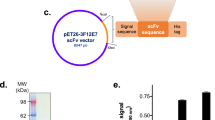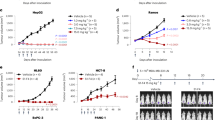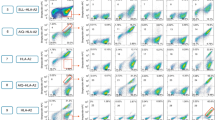Abstract
The tyrosine kinase receptor anaplastic lymphoma kinase (ALK) and its ligand, the growth factor pleiotrophin (PTN), are highly expressed during the development of the nervous system and have been implicated in the malignant progression of different tumor types. Here, we describe human single-chain variable fragment (scFv) antibodies that target the ligand-binding domain (LBD) in ALK and show the effect in vitro and in vivo. The ALK LBD was used as a bait in a yeast two-hybdrid system to select human scFv from a library with randomized complementarity-determining region 3 domains. Surface plasmon resonance showed high-affinity binding of the selected scFv. The anti-ALK scFv competed for binding of PTN to ALK in intact cells and inhibited PTN-dependent signal transduction through endogenous ALK. Invasion of an intact endothelial cell monolayer by U87MG human glioblastoma cells was inhibited by the anti-ALK scFv. In addition, the growth of established tumor xenografts in mice was reversed after the induction of the conditional expression of the anti-ALK scFv. In archival malignant brain tumors expression levels of ALK and PTN were found elevated and appear correlated with poor patient survival. This suggests a rate-limiting function of the PTN/ALK interaction that may be exploited therapeutically.
This is a preview of subscription content, access via your institution
Access options
Subscribe to this journal
Receive 50 print issues and online access
$259.00 per year
only $5.18 per issue
Buy this article
- Purchase on Springer Link
- Instant access to full article PDF
Prices may be subject to local taxes which are calculated during checkout







Similar content being viewed by others
References
Aricescu AR, Siebold C, Choudhuri K, Chang VT, Lu W, Davis SJ et al. (2007). Structure of a tyrosine phosphatase adhesive interaction reveals a spacer-clamp mechanism. Science 317: 1217–1220.
Auf der Maur A, Escher D, Barberis A . (2001). Antigen-independent selection of stable intracellular single-chain antibodies. FEBS Lett 508: 407–412.
Auf der Maur A, Tissot K, Barberis A . (2004). Antigen-independent selection of intracellular stable antibody frameworks. Methods 34: 215–224.
Auf der Maur A, Zahnd C, Fischer F, Spinelli S, Honegger A, Cambillau C et al. (2002). Direct in vivo screening of intrabody libraries constructed on a highly stable single-chain framework. J Biol Chem 277: 45075–45085.
Bao X, Mikami T, Yamada S, Faissner A, Muramatsu T, Sugahara K . (2005). Heparin-binding growth factor, pleiotrophin, mediates neuritogenic activity of embryonic pig brain-derived chondroitin sulfate/dermatan sulfate hybrid chains. J Biol Chem 280: 9180–9191.
Bilsland JG, Wheeldon A, Mead A, Znamenskiy P, Almond S, Waters KA et al. (2007). Behavioral and neurochemical alterations in mice deficient in anaplastic lymphoma kinase suggest therapeutic potential for psychiatric indications. Neuropsychopharmacology, 2008 33: 685–700.
Bowden ET, Stoica GE, Wellstein A . (2002). Anti-apoptotic signaling of pleiotrophin through its receptor, anaplastic lymphoma kinase. J Biol Chem 277: 35862–35868.
Chang Y, Berenson JR, Wang Z, Deuel TF . (2006). Dominant negative pleiotrophin induces tetraploidy and aneuploidy in U87MG human glioblastoma cells. Biochem Biophys Res Commun 351: 336–339.
Chen H, Gordon MS, Campbell RA, Li M, Wang CS, Lee HJ et al. (2007). Pleiotrophin is highly expressed by myeloma cells and promotes myeloma tumor growth. Blood 110: 287–295.
Chiarle R, Voena C, Ambrogio C, Piva R, Inghirami G . (2008). The anaplastic lymphoma kinase in the pathogenesis of cancer. Nat Rev Cancer 8: 11–23.
Chothia C, Lesk AM . (1987). Canonical structures for the hypervariable regions of immunoglobulins. J Mol Biol 196: 901–917.
Chothia C, Novotny J, Bruccoleri R, Karplus M . (1985). Domain association in immunoglobulin molecules. The packing of variable domains. J Mol Biol 186: 651–663.
Czubayko F, Schulte AM, Berchem GJ, Wellstein A . (1996). Melanoma angiogenesis and metastasis modulated by ribozyme targeting of the secreted growth factor pleiotrophin. Proc Natl Acad Sci USA 93: 14753–14758.
Duyster J, Bai RY, Morris SW . (2001). Translocations involving anaplastic lymphoma kinase (ALK). Oncogene 20: 5623–5637.
Fang W, Hartmann N, Chow DT, Riegel AT, Wellstein A . (1992). Pleiotrophin stimulates fibroblasts and endothelial and epithelial cells and is expressed in human cancer. J Biol Chem 267: 25889–25897.
Freije WA, Castro-Vargas FE, Fang Z, Horvath S, Cloughesy T, Liau LM et al. (2004). Gene expression profiling of gliomas strongly predicts survival. Cancer Res 64: 6503–6510.
Grzelinski M, Urban-Klein B, Martens T, Lamszus K, Bakowsky U, Hobel S et al. (2006). RNA interference-mediated gene silencing of pleiotrophin through polyethylenimine-complexed small interfering RNAs in vivo exerts antitumoral effects in glioblastoma xenografts. Hum Gene Ther 17: 751–766.
Hamma-Kourbali Y, Bernard-Pierrot I, Heroult M, Dalle S, Caruelle D, Milhiet PE et al. (2008). Inhibition of the mitogenic, angiogenic and tumorigenic activities of pleiotrophin by a synthetic peptide corresponding to its C-thrombospondin repeat-I domain. J Cell Physiol 214: 250–259.
Henke RT, Eun Kim S, Maitra A, Paik S, Wellstein A . (2006). Expression analysis of mRNA in formalin-fixed, paraffin-embedded archival tissues by mRNA in situ hybridization. Methods 38: 253–262.
Ho M, Nagata S, Pastan I . (2006). Isolation of anti-CD22 Fv with high affinity by Fv display on human cells. Proc Natl Acad Sci USA 103: 9637–9642.
Iwahara T, Fujimoto J, Wen D, Cupples R, Bucay N, Arakawa T et al. (1997). Molecular characterization of ALK, a receptor tyrosine kinase expressed specifically in the nervous system. Oncogene 14: 439–449.
Keese CR, Bhawe K, Wegener J, Giaever I . (2002). Real-time impedance assay to follow the invasive activities of metastatic cells in culture. Biotechniques 33: 842–850.
Kuo AH, Stoica GE, Riegel AT, Wellstein A . (2007). Recruitment of insulin receptor substrate-1 and activation of NF-kappaB essential for midkine growth signaling through anaplastic lymphoma kinase. Oncogene 26: 859–869.
Li F, Shetty AK, Sugahara K . (2007). Neuritogenic activity of chondroitin/dermatan sulfate hybrid chains of embryonic pig brain and their mimicry from shark liver. Involvement of the pleiotrophin and hepatocyte growth factor signaling pathways. J Biol Chem 282: 2956–2966.
Li R, Morris SW . (2007). Development of anaplastic lymphoma kinase (ALK) small-molecule inhibitors for cancer therapy. Med Res Rev, 2008 28: 372–412.
Li YS, Milner PG, Chauhan AK, Watson MA, Hoffman RM, Kodner CM et al. (1990). Cloning and expression of a developmentally regulated protein that induces mitogenic and neurite outgrowth activity. Science 250: 1690–1694.
Lu KV, Jong KA, Kim GY, Singh J, Dia EQ, Yoshimoto K et al. (2005). Differential induction of glioblastoma migration and growth by two forms of pleiotrophin. J Biol Chem 280: 26953–26964.
Maeda N, Ichihara-Tanaka K, Kimura T, Kadomatsu K, Muramatsu T, Noda M . (1999). A receptor-like protein-tyrosine phosphatase PTPzeta/RPTPbeta binds a heparin-binding growth factor midkine. Involvement of arginine 78 of midkine in the high affinity binding to PTPzeta. J Biol Chem 274: 12474–12479.
Maeda N, Nishiwaki T, Shintani T, Hamanaka H, Noda M . (1996). 6B4 proteoglycan/phosphacan, an extracellular variant of receptor-like protein-tyrosine phosphatase zeta/RPTPbeta, binds pleiotrophin/heparin-binding growth-associated molecule (HB-GAM). J Biol Chem 271: 21446–21452.
Maeda N, Noda M . (1998). Involvement of receptor-like protein tyrosine phosphatase zeta/RPTPbeta and its ligand pleiotrophin/heparin-binding growth-associated molecule (HB-GAM) in neuronal migration. J Cell Biol 142: 203–216.
Mathivet T, Mazot P, Vigny M . (2007). In contrast to agonist monoclonal antibodies, both C-terminal truncated form and full length form of Pleiotrophin failed to activate vertebrate ALK (anaplastic lymphoma kinase)? Cell Signal 19: 2434–2443.
McCarthy N . (2008). ALK takes the rap—editorial. Nat Rev Cancer 8: 1.
Meng K, Rodriguez-Pena A, Dimitrov T, Chen W, Yamin M, Noda M et al. (2000). Pleiotrophin signals increased tyrosine phosphorylation of beta beta-catenin through inactivation of the intrinsic catalytic activity of the receptor-type protein tyrosine phosphatase beta/zeta. Proc Natl Acad Sci USA 97: 2603–2608.
Mentlein R, Held-Feindt J . (2002). Pleiotrophin, an angiogenic and mitogenic growth factor, is expressed in human gliomas. J Neurochem 83: 747–753.
Mi R, Chen W, Hoke A . (2007). Pleiotrophin is a neurotrophic factor for spinal motor neurons. Proc Natl Acad Sci USA 104: 4664–4669.
Miura M, Surmacz E, Burgaud JL, Baserga R . (1995). Different effects on mitogenesis and transformation of a mutation at tyrosine 1251 of the insulin-like growth factor I receptor. J Biol Chem 270: 22639–22644.
Moog-Lutz C, Degoutin J, Gouzi JY, Frobert Y, Brunet-de Carvalho N, Bureau J et al. (2005). Activation and inhibition of anaplastic lymphoma kinase receptor tyrosine kinase by monoclonal antibodies and absence of agonist activity of pleiotrophin. J Biol Chem 280: 26039–26048.
Morris SW, Kirstein MN, Valentine MB, Dittmer KG, Shapiro DN, Saltman DL et al. (1994). Fusion of a kinase gene, ALK, to a nucleolar protein gene, NPM, in non- Hodgkin's lymphoma [published erratum appears in Science 1995 Jan 20;267(5196):316–7]. Science 263: 1281–1284.
Morris SW, Naeve C, Mathew P, James PL, Kirstein MN, Cui X et al. (1997). ALK, the chromosome 2 gene locus altered by the t(2;5) in non-Hodgkin′s lymphoma, encodes a novel neural receptor tyrosine kinase that is highly related to leukocyte tyrosine kinase (LTK). Oncogene 14: 2175–2188.
Muramatsu H, Zou P, Kurosawa N, Ichihara-Tanaka K, Maruyama K, Inoh K et al. (2006). Female infertility in mice deficient in midkine and pleiotrophin, which form a distinct family of growth factors. Genes Cells 11: 1405–1417.
Owada K, Sanjo N, Kobayashi T, Mizusawa H, Muramatsu H, Muramatsu T et al. (1999). Midkine inhibits caspase-dependent apoptosis via the activation of mitogen-activated protein kinase and phosphatidylinositol 3-kinase in cultured neurons. J Neurochem 73: 2084–2092.
Padlan EA . (1994). Anatomy of the antibody molecule. Mol Immunol 31: 169–217.
Perez-Pinera P, Alcantara S, Dimitrov T, Vega JA, Deuel TF . (2006). Pleiotrophin disrupts calcium-dependent homophilic cell-cell adhesion and initiates an epithelial-mesenchymal transition. Proc Natl Acad Sci USA 103: 17795–17800.
Perez-Pinera P, Zhang W, Chang Y, Vega JA, Deuel TF . (2007). Anaplastic lymphoma kinase is activated through the pleiotrophin/receptor protein-tyrosine phosphatase beta/zeta signaling pathway: an alternative mechanism of receptor tyrosine kinase activation. J Biol Chem 282: 28683–28690.
Peria FM, Neder L, Marie SK, Rosemberg S, Oba-Shinjo SM, Colli BO et al. (2007). Pleiotrophin expression in astrocytic and oligodendroglial tumors and it's correlation with histological diagnosis, microvascular density, cellular proliferation and overall survival. J Neurooncol 84: 255–261.
Phillips H, Kharbanda S, Chen R, Forrest W, Soriano R, Wu T et al. (2006). Molecular subclasses of high-grade glioma predict prognosis, delineate a pattern of disease progression, and resemble stages in neurogenesis. Cancer Cell 9: 157–173.
Powers C, Aigner A, Stoica GE, McDonnell K, Wellstein A . (2002). Pleiotrophin signaling through anaplastic lymphoma kinase (ALK) is rate-limiting for glioblastoma growth. J Biol Chem 277: 14153–14158.
Powers CJ, McLeskey SW, Wellstein A . (2000). Fibroblast growth factors, their receptors and signaling. Endocr Relat Cancer 7: 165–197.
Qi M, Ikematsu S, Maeda N, Ichihara-Tanaka K, Sakuma S, Noda M et al. (2001). Haptotactic migration induced by midkine. Involvement of protein-tyrosine phosphatase zeta. Mitogen-activated protein kinase, and phosphatidylinositol 3-kinase. J Biol Chem 276: 15868–15875.
Rhodes DR, Yu J, Shanker K, Deshpande N, Varambally R, Ghosh D et al. (2004). ONCOMINE: a cancer microarray database and integrated data-mining platform. Neoplasia 6: 1–6.
Sakaguchi N, Muramatsu H, Ichihara-Tanaka K, Maeda N, Noda M, Yamamoto T et al. (2003). Receptor-type protein tyrosine phosphatase zeta as a component of the signaling receptor complex for midkine-dependent survival of embryonic neurons. Neurosci Res 45: 219–224.
Schaerer-Brodbeck C, Barberis A . (2004). Coupling homologous recombination with growth selection in yeast: a tool for construction of random DNA sequence libraries. Biotechniques 37: 202–206.
Schulte AM, Wellstein A . (1997). Tumour Angiogenesis. In: Bicknell R, Lewis Cm and Ferrara N (eds). Oxford University Press: Oxford, New York, Tokyo, pp 273–289.
Shai R, Shi T, Kremen T, Horvath S, Liau L, Cloughesy T et al. (2003). Gene expression profiling identifies molecular subtypes of gliomas. Oncogene 22: 4918–4923.
Soda M, Choi YL, Enomoto M, Takada S, Yamashita Y, Ishikawa S et al. (2007). Identification of the transforming EML4-ALK fusion gene in non-small-cell lung cancer. Nature 448: 561–566.
Stoica GE, Kuo A, Aigner A, Sunitha I, Souttou B, Malerczyk C et al. (2001). Identification of ALK (anaplastic lymphoma kinase) as a receptor for the growth factor pleiotrophin. J Biol Chem 276: 16772–16779.
Stoica GE, Kuo A, Powers C, Bowden ET, Buchert-Sale E, Riegel AT et al. (2002). Midkine binds to anaplastic lymphoma kinase (ALK) and acts as a growth factor for different cell types. J Biol Chem 277: 35990–35998.
Sugahara K, Mikami T . (2007). Chondroitin/dermatan sulfate in the central nervous system. Curr Opin Struct Biol 17: 536–545.
Sun L, Hui AM, Su Q, Vortmeyer A, Kotliarov Y, Pastorino S et al. (2006). Neuronal and glioma-derived stem cell factor induces angiogenesis within the brain. Cancer Cell 9: 287–300.
Tang Y, Lou J, Alpaugh RK, Robinson MK, Marks JD, Weiner LM . (2007). Regulation of antibody-dependent cellular cytotoxicity by IgG intrinsic and apparent affinity for target antigen. J Immunol 179: 2815–2823.
Weber D, Klomp HJ, Czubayko F, Wellstein A, Juhl H . (2000). Pleiotrophin can be rate-limiting for pancreatic cancer cell growth. Cancer Res 60: 5284–5288.
Wellstein A, Fang WJ, Khatri A, Lu Y, Swain SS, Dickson RB et al. (1992). A heparin-binding growth factor secreted from breast cancer cells homologous to a developmentally regulated cytokine. J Biol Chem 267: 2582–2587.
Zhang N, Zhong R, Wang ZY, Deuel TF . (1997). Human breast cancer growth inhibited in vivo by a dominant negative pleiotrophin mutant. J Biol Chem 272: 16733–16736.
Zou P, Muramatsu H, Sone M, Hayashi H, Nakashima T, Muramatsu T . (2006). Mice doubly deficient in the midkine and pleiotrophin genes exhibit deficits in the expression of beta-tectorin gene and in auditory response. Lab Invest 86: 645–653.
Acknowledgements
We thank Drs Emma T Bowden, Angera H Kuo and Gerald E Stoica (Georgetown University) for help with some of the experiments as well as discussions and suggestions. This work was supported by RO1 CA108440 from the National Institute of Health (to AW).
Author information
Authors and Affiliations
Corresponding author
Rights and permissions
About this article
Cite this article
Stylianou, D., Auf der Maur, A., Kodack, D. et al. Effect of single-chain antibody targeting of the ligand-binding domain in the anaplastic lymphoma kinase receptor. Oncogene 28, 3296–3306 (2009). https://doi.org/10.1038/onc.2009.184
Received:
Revised:
Accepted:
Published:
Issue Date:
DOI: https://doi.org/10.1038/onc.2009.184
Keywords
This article is cited by
-
New perspectives for targeting therapy in ALK-positive human cancers
Oncogene (2023)
-
Fibroblast Growth Factor Binding Protein 3 (FGFBP3) impacts carbohydrate and lipid metabolism
Scientific Reports (2018)
-
Targeting oncogenic ALK and MET: a promising therapeutic strategy for glioblastoma
Metabolic Brain Disease (2013)
-
The synthetic peptide P111-136 derived from the C-terminal domain of heparin affin regulatory peptide inhibits tumour growth of prostate cancer PC-3 cells
BMC Cancer (2011)



